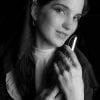Planning, setting the scene, basic edits
Notes and assumptions:
For the purpose of this article assume that monochromatic means greyscale or black and white. Also note that this article covers the basics and whilst there are exceptions or additions to some of the points detailed below, I will cover those in a separate article. High contrast doesn't mean crushed blacks and blown highlights - we are trying to achieve a balance where the detail is shown from deep shadow through to the bright areas of the image. Apart from the final image I've used screenshots so you can see what settings I've used or changed along the way and to demonstrate that there is no cheating going on ![]()
When I have an idea for a shot I will know beforehand if I intend to produce a colour image or monochromatic; yes it is more than possible in the digital age to take a batch of images and then decide afterwards if you are going to convert any of them but you are relying more on luck than judgement to get a good black and white rather than visualising the shot in advance.
Planning
In your pre-shoot comms you will need to explain to the model that they will require little to no-make-up and certainly no bold lipstick or eye shadow - blending different skin tones on a colour image is bad enough - it's a nightmare in monochrome. If you're shooting nudes and their face and neck are a different colour to their body AND they have tanlines - expect a whole world of pain in Photoshop afterwards. Likewise with clothing, avoid bold coloured patterns or colours that will clash in a black and white conversion.
Setting the scene and lighting
If you are shooting outdoors prepare to break a few rules, it's OK to shoot in full sun with harsh shadows - you can use a white reflector to bounce light back to soften them on the face or body but you probably want the textures created on your surroundings. It's OK to shoot in areas where there is a huge range of exposure values, this will give your final image plenty of contrast and depth.
In a studio you will be lighting to produce texture and contrast, soft black and white portraits are one thing but for anything else clarity, contrast and texture are your friends today.
Your scene or set should reflect the nature of the image you want to produce, be aware of where shadows are going to fall or where light is reflected, these will have a greater effect on your final image than the same in a softly lit colour shot.
In the shot below I'm using harsh sunlight to illuminate the white cloth on the table and Becky's left leg, I've positioned a silver reflector to throw more light on to her right leg and her habit because they were both in heavily shadowed areas. The histogram is all but meaningless, it only tells me that the majority of this image is very dark; had I lit the scene for a textbook balanced histogram I'd be looking at producing a very flat and boring BW image.
I shoot in RAW and I work from RAW - I do have a dual card camera and could shoot in both with the JPEGS set to black and white but these only show a desaturated version of a colour image and this is a false representation of what I want to achieve and could therefore lead me astray.
You will notice that for this image I shot a stop higher than the subsequent images, this was only to ensure I could show more of the shadow detail for this screenshot.

In the next image I have moved to where I want to take the shot from - I wanted a voyeuristic feel and had decided to shoot from between a pair of hanging curtains. I have metered for the point where Becky's left shoulder is against the cross, this will enable me to get a good range of light across the whole photograph and to get the sharpest details in the centre of the image, I want to be particularly careful that I keep the detail on the white parts of her habit - blow the highlights here and they are gone forever. Again, note that the histogram only serves to tell me the image is very dark overall, but using our very own "mark one eyeball" we can see where the highlights are going to provide definition to Becky's profile and legs.

Editing
I've taken the image I want and I've sent Becky home for a well earned glass of rum. Now for the editing...
Notice the histogram shows a shift towards the midtones, this is because Becky's pose (as opposed to the test shot above) presents the bottle and the white of her habit towards the light.
First I'm going to choose the crop that I find works best with the image. This might seem obvious but you'd be surprised how many people work off the full size and choose their crop afterwards, only to find that their gradients or vignettes don't match the finished article.

Select "Black and White" treatment to begin your edit.

Because of my lighting and my chosen exposure I don't need to do much with the global settings, I could probably export and publish the image as is but I really want to show off some of the details and get as much contrast out of it as I can so I make some slight tweaks to contrast, highlights, shadows etc. the main difference is that I have pushed my clarity as high as possible without getting a halo between light and dark areas of the image. I have also used (but didn't screenshot) the gradient tool to bring up the exposure on the curtains by 2/3rds of a stop to prevent them looking like black triangles.
Note: I could also use the curve tool to independently, or in addition, adjust or fine tune my shadows and highlights (I'll cover this in a subsequent article).

Finally, and this is purely a personal choice but, in images like this I like to use a subtle hint of split tone as well as some (OK a lot of) grain and noise.

Summary
I've deliberately steered clear of using channels, layers in Photoshop, curves and all of the other goodies that will give you a good black and white image. What I have done is attempted to show that with thought and preparation you can capture a colour RAW and get a great monochromatic image with a single click in post. I strongly suggest you do tweak the contrast etc to develop your image to bring out the best of it but the hard work has been done with your lighting and scene setting before you've even pressed the shutter release.


